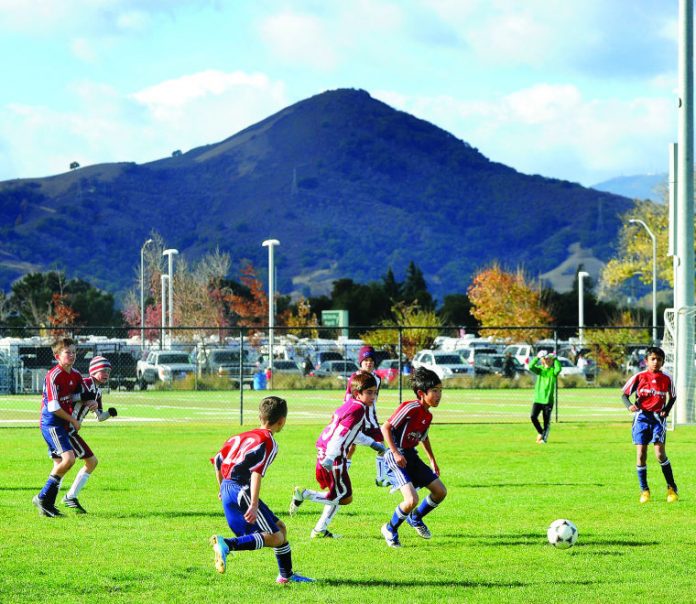
The future of recreation in Morgan Hill depends on you, but City officials are already certain the need for more or bigger sports and recreation options will continue to rise as the population grows.
The City of Morgan Hill is asking residents to fill out an online survey regarding the needs and desires for new facilities, as well as ideas on the possible expansion or upgrade of existing facilities.
City staff will use the responses, along with other information, to determine if the Council should consider a new funding source – such as a “community center impact fee” – devoted solely to recreation development. The idea of such a fee is only in the preliminary stages, and the potential details – including the cost and revenue generated – won’t be known until the City conducts a thorough study.
“I think we have a reputation as a city for our recreation facilities, and to make sure we’re keeping up with the public in terms of what they want is very important,” Morgan Hill Mayor Steve Tate said. “The combination of being able to accommodate local residents and being able to draw people from the outside is important.”
The City in 2010 discontinued a recreation impact fee formerly imposed on developers after City staff and a consultant, Willdan, recommended its elimination.
In recent years, the City’s now-shuttered Redevelopment Agency funded some of the local flagship public recreation facilities including the Centennial Recreation Center, Aquatics Center and Community and Cultural Center.
But the former community center impact fee did its share, funding the development of the 38-acre Outdoor Sports Complex ($104,000), a parking lot expansion at the CRC ($189,000), and a CRC fitness expansion ($91,000), according to City staff.
The fee raised about $400,000 since it was established in 2005, according to City staff.
Now the Council wants to revisit the community center impact fee, and the “I (heart) Morgan Hill Recreation” survey on the City’s website is a step toward that effort.
The seven-question survey, which went live last week and is available in English and Spanish, asks respondents what they like about existing facilities, what features or amenities could be added to current recreation centers and what type of new recreation facilities or community centers will be needed in Morgan Hill.
The survey will be open until Jan. 15, 2014, after which City staff will tally the results and use them in a further study of future needs and potential funding sources.
Most recently, the Council has voiced a strong desire and a need for new baseball and softball fields.
The City is currently in the pre-purchase “due diligence” period to buy a 25-acre vacant parcel in the Southeast Quadrant for the development of a new ball fields complex. The Council prefers a facility that can host regional tournaments to draw visitors and their wallets from out of town.
The City has money to purchase the property – about $8 million in a “park impact fund” – but nothing to develop ball fields and supporting facilities on the site, according to Tate.
The park impact fund is reserved solely for property purchases, or “land banking” for future parks and recreation facilities, according to City staff.
Another potential recreation need in Morgan Hill is at the tennis courts at the Community Park, as Tate said members of the Morgan Hill Tennis Club have told him they would like lights over the courts.
The City has two other parks-related funds that are financed by developers. One is an open space fund, and the other is a “park maintenance fund” to which developers contribute voluntarily in order to gain points in the City’s residential development competition process, according to City Manager Steve Rymer.
A new community center impact fee would be heavily restricted by state law, Rymer said.
“The community center impact fee was developers (paying) into the impact fund, to pay for additional capacity due to additional growth,” Rymer explained. “It has to pay for growth (and) we can’t adopt a fee until we understand what the overall needs are.”
There’s little doubt among City officials and local sports fans that the need for more or bigger recreation facilities will continue to grow in Morgan Hill. Some of the City’s facilities – including the CRC and Aquatics Center – recently achieved full cost recovery due to the increasing number of memberships.
Jeff Dixon, president of the Morgan Hill Youth Sports Alliance, agreed the City is “overdue” for a baseball facility. The City’s existing ball fields are scattered in different parks throughout town, and youth leagues practice and play on various Morgan Hill Unified school fields.
And it’s obvious to Dixon, whose MHYSA runs the Outdoor Sports Complex, that attendance at the facilities he frequents is steadily on the rise.
“I think that speaks to the quality of our facilities, that more and more people use them and there might be a need for more,” Dixon said. “These are quality facilities that you don’t find in every city.”
He added it’s impressive that the City is planning ahead for future recreation needs, rather than reacting to growing populations when it’s too late as other cities have done.
Morgan Hill Vice Mayor Gordon Siebert noted that a recreation impact fee to pay for the needs of future residents is as “reasonable” as any other impact fee charged to developers. He added he would like to see more bicycle and pedestrian paths or trails in the City, similar to those existing along the Llagas Creek channel on the west side of Monterey Road south of town.
“It’s easy to acquire the right-of-way (for such trails), and not necessarily impact the security and safety of adjacent residents,” Siebert said.
To let the City of Morgan Hill know about your views on the need for future new recreation facilities, or the expansion or upgrade of existing ones, fill out an online survey on the City’s website at www.morganhill.ca.gov.







